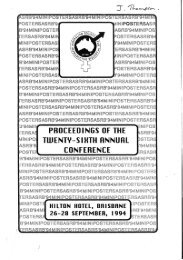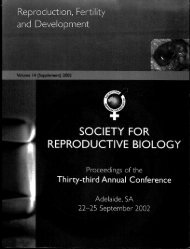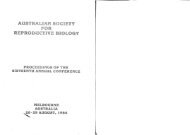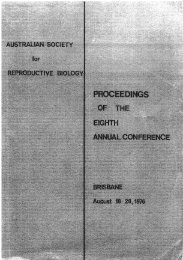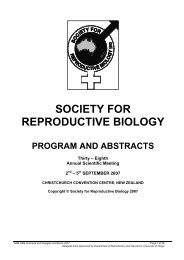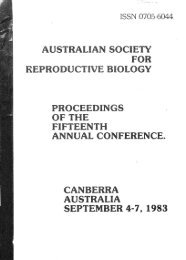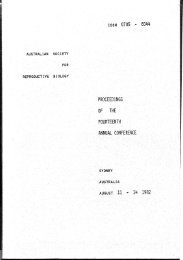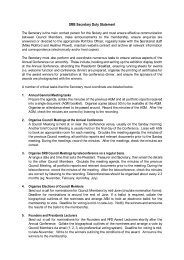N OCIETY' - the Society for Reproductive Biology
N OCIETY' - the Society for Reproductive Biology
N OCIETY' - the Society for Reproductive Biology
Create successful ePaper yourself
Turn your PDF publications into a flip-book with our unique Google optimized e-Paper software.
MICROMANIPULATION PROCEDURES FOR GAMETES AND EMBRYOSO. Lacham-Kaplan, G. M. Jones, A. TrounsonCentre For Early Human Development, Institute of Reproduction and Development, MonashUniversity Melbourne, Victoria, AustraliaMicromanipulation procedures have been used as an artificial reproductive technology (ART) <strong>for</strong> <strong>the</strong>treatment of infertility in <strong>the</strong> human and o<strong>the</strong>r mammalian species. The zona pellucida, surrounding<strong>the</strong> mammalian oocyte is <strong>the</strong> major barrier to fertilization. Sperm must pass through this layer inorder to reach and fuse with <strong>the</strong> oocyte membrane and initiate embryonic development. The zonapellucida is also believed to protect <strong>the</strong> embryo during its preimplantation development in-vivo.Upon implantation in <strong>the</strong> uterus embryos at <strong>the</strong> blastocyst stage expand and exit from <strong>the</strong> zonapellucida in a process known as 'hatching'. The zona pellucida may prevent fertilization of oocytesby subfertile sperm. Moreover, due to abnormal thickening and hardening of <strong>the</strong> zona pellucidaembryos may fail to hatch, hence reducing <strong>the</strong> chances of implantation and pregnancies. In <strong>the</strong>secases, breaching or complete removal of <strong>the</strong> zona pellucida is necessary. Breaching of <strong>the</strong> zonapellucida is mainly done by micromanipulation procedures.To facilitate fertilization, a microneedle is used to penetrate <strong>the</strong> zona pellucida and leave <strong>the</strong> spermin close proximity to <strong>the</strong> plasma membrane or directly inside <strong>the</strong> oocyte cytoplasm in a processknown as intracytoplasmic sperm injection (lCS!). In this procedure, sharp glass capillaries areoperated manually to pierce <strong>the</strong> zona pellucida and <strong>the</strong> plasma membrane. Using lCSl, fertilizationwith very low numbers of normal sperm, immotile sperm, epididymal and testicular sperm, and germcells such as round spermatids and secondary spermatocytes have been achieved in humans and ino<strong>the</strong>r mammalian species. These include mice, horses, cows, domestic cats and o<strong>the</strong>rs and may be<strong>the</strong> optimal procedure to be used <strong>for</strong> conservation of endangered species.Intracytoplasmic injection is also used to inject somatic cells into enucleated oocytes <strong>for</strong> <strong>the</strong> purposeof cloning farm and laboratory animals. A recent use of non-sharp microinjection capillaries attachedto a Piezo system, which is operated by electromagnetic pulses, has been shown to be less invasiveand more effective when germ cells and somatic cells were injected directly into <strong>the</strong> oocytecytoplasm.Assisted hatching and embryo biopsy <strong>for</strong> preimplantation diagnosis in <strong>the</strong> human are also done usingmicromanipulation procedures to partially remove <strong>the</strong> zona pellucida. Partial removal of <strong>the</strong> zonapellucida can be done chemically using low p~_ solutions, mechanically by a sharp microneedle, orby laser. The laser system <strong>for</strong> assisted hatching has been found to be easier to handle and morereproducible than <strong>the</strong> o<strong>the</strong>r two assisted hatching procedures. Using a laser beam directed on acertain point of <strong>the</strong> zona pellucida, accurate and repeatable holes are created. The procedure is safeand does not interfere with embryo development. The laser system offers a significantmethodological improvement over <strong>the</strong> chemical and mechanical assisted hatching. The threeprocedures are found to enhance implantation and pregnancies in cases of failed IVF due to ei<strong>the</strong>rthick or hardened zonae, suggesting that <strong>the</strong> techniques may be beneficial <strong>for</strong> all IVF producedembryos.3435




